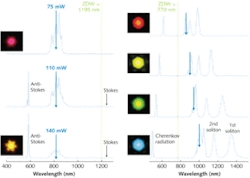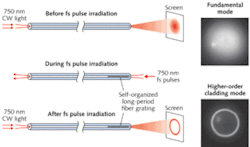One decade ago a seemingly straightforward attempt to pass femtosecond laser pulses through a microstructured pure-silica fiber by several Bell Labs investigators initiated the so-called supercontinuum revolution in the rapidly evolving field of nonlinear fiber optics. Today, fiber supercontinuum generation has become commonplace due to its relatively simple setup, and has found numerous interdisciplinary applications.
Supercontinuum generation has been deconstructed into a mixture of well-known nonlinear optical processes through which the energy of an input femtosecond pulse is spread rather uniformly across a continuum of spectral bands that includes the starting spectrum of the pulse. The initial surprise associated with the fiber supercontinuum has long passed. So, what’s next?
Perhaps new insights can be gained from the original observation of the fiber supercontinuum phenomenon. What makes this experiment visually striking is that an invisible infrared laser beam is transformed inside the microstructured fiber into an intense white light that illuminates the entire fiber in a dark ultrafast laboratory. Would it be equally striking if the infrared laser beam could be transformed inside a microstructured fiber into an intense (multimilliwatt-level) colored light of choice, rather than a broad spectrum of white light? Or more technically, can the energy of the laser pulse (pump) be routed to a targeted anti-Stokes band (signal) having a wavelength shorter than the laser wavelength, rather than be nonspecifically spread into a supercontinuum?
It is obvious that such targeted routing of femtosecond pulse energy (TRFPE) is mutually exclusive with supercontinuum generation. The promotion of the former necessitates the suppression of the latter, and vice versa. The key strategy to promote supercontinuum generation is to match the zero-dispersion wavelength (ZDW) of the fiber with the laser wavelength, so that the input pulse sustains a high peak intensity over a long (more than 1 m) fiber length to enhance all the nonlinear optical processes. Thus, TRFPE can be achieved by detuning the ZDW of the fiber far away (more than 100 nm) from the laser wavelength. This operating regime, called the short nonlinear-interaction condition, has been highly uncommon because it could similarly suppress the intended nonlinear processes that promote TRFPE. Somewhat surprisingly, recent developments have realized robust TRFPE under the short nonlinear-interaction condition through intermodal four-wave mixing and soliton-mediated Cherenkov radiation.
Intermodal four-wave mixing
Four-wave mixing (FWM) is a well-known physical process to achieve TRFPE. Unfortunately, the phase-matching condition of conventional fiber-optic FWM forbids the efficient stimulation of the process under the short nonlinear-interaction condition. Thus, the supercontinuum onset has largely restricted the pump-to-signal conversion efficiency to within 2%, preventing the generation of a multimilliwatt-level signal.
Interestingly, the above fundamental restriction can be lifted by fulfilling the phase-matching condition through an intermodal scheme in which the pump and the signal propagate in different fiber modes (see Fig. 1).1 The FWM with such a phase-matching scheme, termed the intermodal FWM, is stimulated at a deeply normal dispersion regime of a microstructured fiber. In other words, the microstructured fiber is designed to have a large mode area (approximately 40 µm2) so that its ZDW (approximately 1200 nm) is detuned far to the red from the Ti:sapphire laser wavelength of around 800 nm. More than 7% conversion efficiency from the pump input to the yellow 586 nm signal has been obtained under such short nonlinear-interaction conditions, enabling the generation of a multimilliwatt-level signal without noticeable contamination from the supercontinuum generation. The signals of different colors can be generated by a series of similarly microstructured fibers having slightly different ZDWs.
Why can the intermodal FWM be so efficient under the short nonlinear-interaction condition? It should be noted that the efficiency of the conventional single-mode FWM is usually limited by the walk-off length of the ultrashort pump and signal (or idler) pulses, which can be comparable or shorter than the nonlinear-interaction length of the pump pulse. As a result, the short nonlinear-interaction condition itself does not necessarily lead to low FWM efficiency. On the other hand, this condition minimizes all nonspecific frequency conversion processes so that the input pulse predominantly releases its energy through the intermodal FWM. In other words, such conditions favor the phase-matched (resonant) frequency conversion process of the FWM over all non-phase-matched (nonresonant) frequency conversion processes of the supercontinuum generation.
Soliton-mediated Cherenkov radiation
The intermodal FWM is useful to generate large-pulse-energy signals because amplified microjoule pulses are needed to stimulate the process in large-mode-area microstructured fibers. Because the corresponding laser source is bulky, efforts should be made to realize TRFPE from compact femtosecond lasers producing unamplified nanojoule pulses. To stimulate nonlinear effects from these low-energy pulses, the microstructured fiber is designed to have a small mode area (approximately 2 µm2) so that its ZDW becomes shorter than the laser wavelength, or equivalently, the fiber is pumped at an anomalous dispersion regime where optical solitons rule. On one hand, the temporal compression of the solitons can emit light at a phase-matched spectral band called Cherenkov radiation, which can be used to achieve the TRFPE. On the other hand, Cherenkov radiation has been considered as one mechanism shaping the short-wavelength edge of the supercontinuum.
This intriguing controversy was recently resolved by generating Cherenkov radiation under the short nonlinear-interaction condition attained at a deeply anomalous dispersion regime of the fiber (see Fig. 1).2 This experiment definitely reveals the narrowband nature of Cherenkov radiation that has long been obscured by the supercontinuum generation under long nonlinear-interaction conditions.
The reasons that the Cherenkov radiation can be so efficient under the short nonlinear-interaction condition parallel those that explain the intermodal FWM. Because the Cherenkov radiation is typically completed within the first few centimeters of the fiber, the short nonlinear-interaction condition has little influence on its efficiency. But this condition adversely affects all the competing nonresonant frequency conversion processes of the supercontinuum generation to gain the energy from the pump pulse. The pump-to-signal conversion efficiency routinely surpasses 10%, enabling the generation of multimilliwatt Cherenkov radiation signals.
While the tunability of the Cherenkov radiation can be facilitated by tuning the pump wavelength of a widely tunable unamplified Ti:sapphire laser, an alternative approach is to pump a series of photonic-crystal fibers (PCFs) with ZDWs ranging from 700 to 950 nm at a constant wavelength of approximately 1050 nm afforded by a compact neodymium:glass femtosecond laser or ytterbium-doped femtosecond fiber laser. The compact module of parallel-mounted short PCFs can add to such a source the capability of a widely tunable visible picosecond laser, or femtosecond laser if the Checkhov-radiation pulse is compressible.
Spectral vs. spatial
The idea of TRFPE has so far been discussed in the context of optical-frequency upconversion of femtosecond laser sources. This idea, however, can be further generalized. The pulse energy, instead of being nonlinearly routed to a different spectral band, is nonlinearly routed to a different spatial mode; that is, from the fundamental mode to the second-order mode of a microstructured fiber.3 This experiment suggests that the copropagating source mode and secondary mode can interfere with each other along the fiber axis to produce a permanent long-period fiber grating through photosensitivity wherein the pulse energy irreversibly deposits to periodic spatial locations along the fiber. Such self-written fiber gratings have recently been observed from small mode areas but otherwise conventional single-mode germanosilicate fibers as the result of the pulse energy being routed to an ultrahigh-order cladding mode (see Fig. 2).4Although the exact mechanism remains unclear as to why the pulse energy is routed to one specific cladding mode rather than to dozens (or hundreds) of cladding modes afforded by the fiber, convincing evidence has linked the specific cladding mode to the one that couples most efficiently with the source mode. This fact classifies the grating as a self-organized structure whose period is dictated by the dielectric specifics of the fiber, and therefore opens up great opportunities to engineer the grating using microstructured fibers. The spontaneous grating formation also explains the long-term instability of supercontinuum-generating microstructured fibers widely observed at high (peak) pump intensity, demonstrating the mutual exclusion of the spatial TRFPE with the supercontinuum generation that demands stable single-mode operation.
Nonsupercontinuum applications
The concept of spectral and spatial TRFPE sharply contradicts the original idea of supercontinuum generation, and yet uses the same simple laboratory setup. The spectral TRFPE addresses the increasing demands of compact and cost-effective ultrafast narrowband sources in ultrafast spectroscopy, photochemistry, multiphoton microscopy, and nonlinear biomedical imaging. In particular, tunable visible ultrafast sources based on Chekhov radiation can replace their bulky and expensive counterparts that use Ti:sapphire laser-pumped optical parametric oscillators or argon laser-pumped dye lasers.
The spatial TRFPE concept is a novel method to fabricate long-period fiber gratings, which have found widespread applications in telecommunications and biosensing. The method has produced gratings involving ultrahigh-order cladding modes and visible spectral regions, which have been difficult to fabricate from conventional methods. The mechanism itself permits the fabrication of similar mode-coupling photonic devices in various waveguiding channels. In both cases, microstructured fibers are preferred over the conventional circular fibers because they offer the utmost flexibility of dispersion engineering demanded by both the spectral and the spatial TRFPE. We believe these nonsupercontinuum applications have great potential to depart from mainstream nonlinear fiber optics and initiate another round of active research.
REFERENCES
- H. Tu et al., Appl. Phys. Lett. 94, p. 101109 (2009).
- H. Tu and S.A. Boppart, Opt. Express 17, p. 9858 (May 2009); www.opticsinfobase.org/oe/abstract.cfm?URI=oe-17-12-9858
- H. Tu et al., Optics Express 16, p. 5617 (2008).
- H. Tu et al., Opt. Lett. 34, p. 668 (2009).

